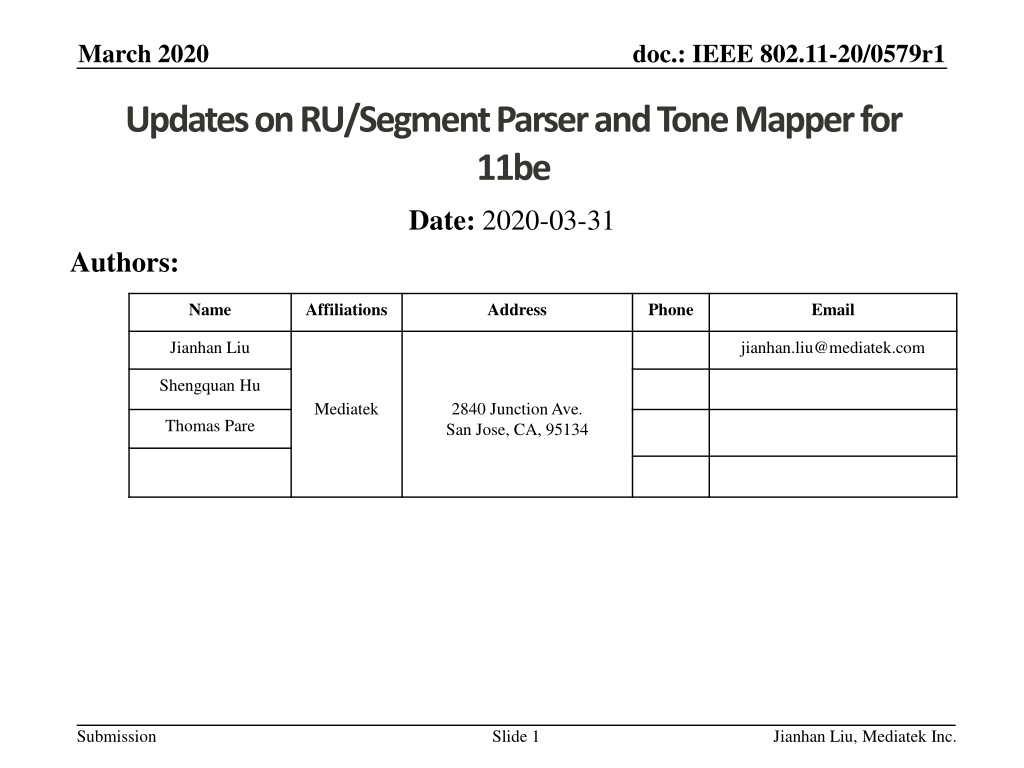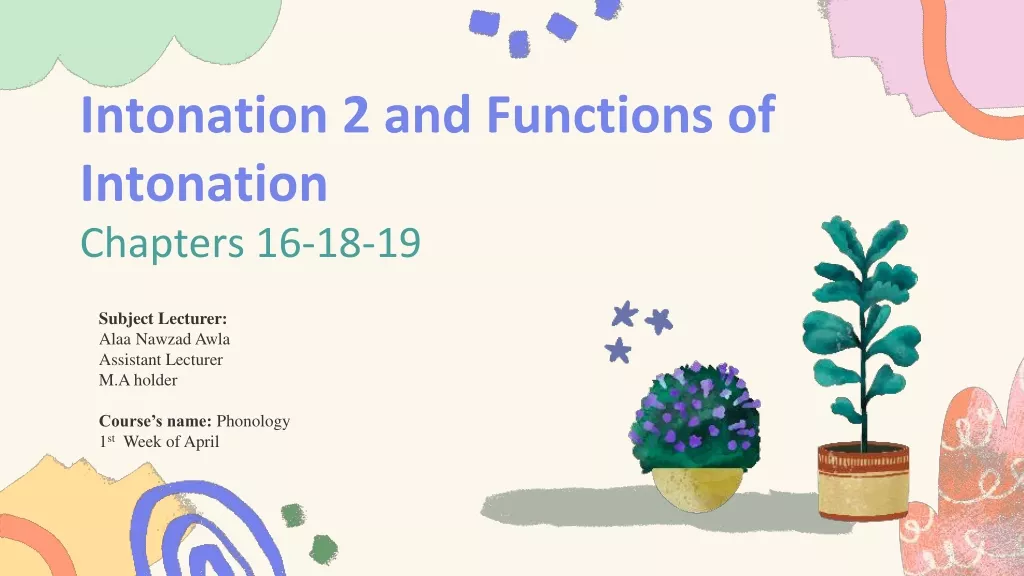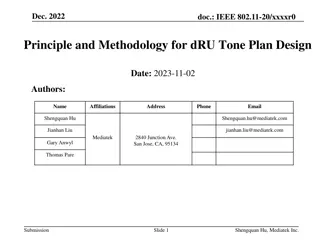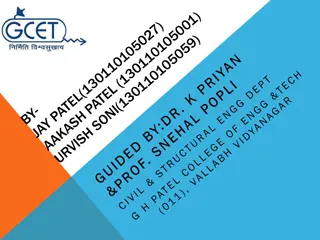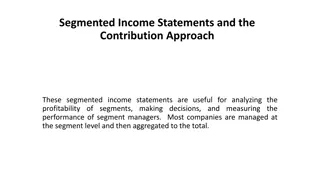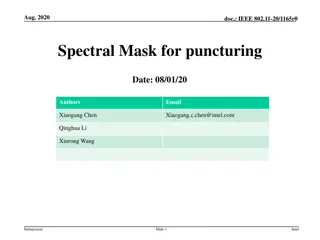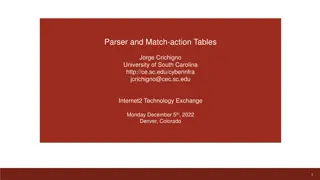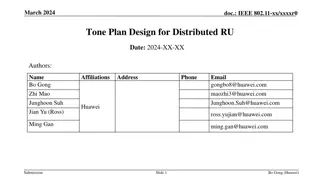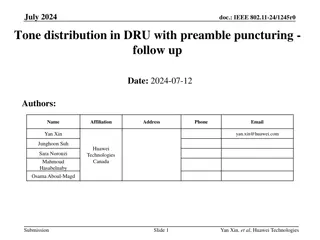Updates on RU/Segment Parser and Tone Mapper for 11be
This document outlines recent developments in the RU/Segment Parser and Tone Mapper for IEEE 802.11be technology. It discusses straw polls, LDPC tone mapper schemes, proportional round robin implementation, and examples of RU aggregation. Additionally, various options for segment parsers are explored in detail.
Download Presentation

Please find below an Image/Link to download the presentation.
The content on the website is provided AS IS for your information and personal use only. It may not be sold, licensed, or shared on other websites without obtaining consent from the author. Download presentation by click this link. If you encounter any issues during the download, it is possible that the publisher has removed the file from their server.
E N D
Presentation Transcript
March 2020 doc.: IEEE 802.11-20/0579r1 Updates on RU/Segment Parser and Tone Mapper for 11be Date: 2020-03-31 Authors: Name Affiliations Address Phone Email Jianhan Liu jianhan.liu@mediatek.com Shengquan Hu Mediatek 2840 Junction Ave. San Jose, CA, 95134 Thomas Pare Submission Slide 1 Jianhan Liu, Mediatek Inc.
March 2020 doc.: IEEE 802.11-20/0579r1 Introduction The following straw polls have been passed [1]: Do you support joint interleaving for RU and aggregated RU size <=80 MHz? Do you agree with the following LDPC tone mapper scheme for multi-RU aggregation in 11be? For aggregated RUs and PPDU BW larger than 80MHz, separate LDPC tone mapper is applied in each 80MHz segment. Do you agree that 11be uses 80MHz segment parser with proportional round robin (PRR) scheme? The detailed tone mapper schemes have been decided with passed straw polls for DTM for different size of combined Rus. The detailed proportional round robin (PRR) scheme is still not decided. We provide more simulation results and discussions to finalize the PRR scheme. Submission Slide 2 Jianhan Liu, Mediatek Inc.
March 2019 doc.: IEEE 802.11-20/0579r1 Recap on Proportional Round Robin (PRR) Scheme Submission Slide 3 Jianhan Liu, Mediatek Inc.
March 2020 doc.: IEEE 802.11-20/0579r1 Example for 484+996 in 160MHz 484+996-tone RU Aggregation tone interleaved within 80MHz Submission Slide 4 Jianhan Liu, Mediatek Inc.
March 2020 doc.: IEEE 802.11-20/0579r1 Joint Interleave v.s. Separated Tone Interleaver For RU aggregation crossing 80MHz segments and 160/240/320MHz PPDU, we compared the performance of joint tone interleave and separate tone interleave. To get optimal DTM, we allow some tones (Ndrop) are not interleaver. DTM for joint tone interleave crossing 80MHz segment RU combine 484+996 (242+484)+996 484+2*996 484+3*996 2*996 3*996 4*996 vNsd 1448 1682 2428 3408 1960 2940 3920 Dtm Ndrop 38 or (32) or (36) or (30) 41 or (40) or (29) or (35) 55 (or 44) 71 (or 48) 40 60 or (49) 80 or (70) or (56) 4 or (8) or (8) or (8) 1 or (2) or (0) or (2) 8 (or 8) 0 (or 0) 0 0 or (0) 0 Submission Slide 5 Jianhan Liu, Mediatek Inc.
March 2020 doc.: IEEE 802.11-20/0579r1 Options for Segment Parser Sequential parser Sequentially distribute the coded bits to each 80 MHz segments: assign all the coded bits to the 1st 80MHz segment first. After it fills up, move on to the 2nd 80MHz segment, and so on. Round robin parser (11ax method) Start with round robin distribution among all 80MHz segments, NBPSCS/2 coded bits to 80MHz segment 1 followed by NBPSCS/2 to 80MHz segment 2, etc. When a smaller 80MHz segment fills up, all the remaining bits are round robin distributed among remaining larger segments Proportional round robin parser For any RU aggregations, taking ?1 bit-blocks (s) to RU #1, taking ?2 bit-blocks (s) to RU#2 alternatively according to RU-size. m1bit-Blocks for RU #1 m1bit-Blocks for RU #1 m1 bit-Blocks for RU #1 Left-over bit-Blocks for RU with left tones m2 bit-Blocks for RU #2 m2 bit-Blocks for RU #2 m2 bit-Blocks for RU #2 Submission Slide 6 Jianhan Liu, Mediatek Inc.
March 2020 doc.: IEEE 802.11-20/0579r1 Proposed RU/Segment Parser Two factors to evaluate: How ?1 and ?2 affect the performance? How left-over bits affect the performance? Proposed ratio m1:m2:m3:m4 for proportional round robin parser Proportional Ratio (m1:m2:m3:m4) Leftover bits (per symbol) RU Aggregation Nsd_total 484+996 (242+484)+996 484+2*996 484+3*996 2*996 3*996 4*996 1448 1682 2428 3408 1960 2940 3920 1s:2s 3s:4s 1s:2s:2s 1s:2s:2s:2s 1s:1s 1s:1s:1s 1s:1s:1s:1s 44*Nbpscs on ru996 44*Nbpscs on ru996 44*Nbpscs on ru996 44*Nbpscs on ru996 0 0 0 Where: Submission Slide 7 Jianhan Liu, Mediatek Inc.
March 2020 doc.: IEEE 802.11-20/0579r1 Summary on Results in [2] Simulation results show that the smallest proportion provides the best performance. Larger proportion causes 0.2dB to 0.6dB performance loss. Simulation results show that joint tone interleave crossing 80MHz segment has almost the same performance as proportional round robin. Joint tone interleave crossing 80MHz segment requires significant architecture change. Optimal DTM for joint tone interleave needs extra processing on dropped out tones. Different treatments on left-over bits have no impact on performance. The simplest scheme is to apply the same proportional round robin on left- over bits. Submission Slide 8 Jianhan Liu, Mediatek Inc.
March 2019 doc.: IEEE 802.11-20/0579r1 Updated Slides Added the formula description of the proposed propositional round robin scheme. Added simulations of proposed segment parser under channel D. Added discussions and comparison with schemes proposed in [3] and [4]. Submission Slide 9 Jianhan Liu, Mediatek Inc.
March 2019 doc.: IEEE 802.11-20/0579r1 Proportional Round Robin Parser (1/3) Proportional Ratio (m0:m1:m2:m3) 1s:2s 3s:4s 1s:2s:2s 1s:2s:2s:2s 1s:1s 1s:1s:1s 1s:1s:1s:1s Leftover bits (per symbol) 44*Nbpscs on ru996 44*Nbpscs on ru996 44*Nbpscs on ru996 44*Nbpscs on ru996 0 0 0 RU combine Nsd_total 484+996 (242+484)+996 484+2*996 484+3*996 2*996 3*996 4*996 1448 1682 2428 3408 1960 2940 3920 Where: To 2nd RU996 To 1st RU996 Leftover bits Submission Slide 10 Jianhan Liu, Mediatek Inc.
March 2019 doc.: IEEE 802.11-20/0579r1 Proportional Round Robin Parser (2/3) NOTE: this generalized equation works for all cases of RU aggregations, such as 484+2x996, 3x996, 2x996, etc Submission Slide 11 Jianhan Liu, Mediatek Inc.
March 2019 doc.: IEEE 802.11-20/0579r1 Proportional Round Robin Parser (3/3) Submission Slide 12 Jianhan Liu, Mediatek Inc.
March 2019 doc.: IEEE 802.11-20/0579r1 11ax Segment Parser vs. 11be PRR Parser 11ax segment parser: 11be PRR segment parser: Submission Slide 13 Jianhan Liu, Mediatek Inc.
March 2019 doc.: IEEE 802.11-20/0579r1 Simulations of Proportional Round Robin Parser (over D-NLOS channel) Submission Slide 14 Jianhan Liu, Mediatek Inc.
March 2019 doc.: IEEE 802.11-20/0579r1 BW160, RU484+996, D-NLOS, MCS7, 2x1 BW160,RU484+996,D-NLOS,2x1,BF on, MCS: [7 7], LDPC,Estimated Channel, PktLen=4KB 0 10 joint tone mapper,Dtm=32, Ndrop=8: sensSNR=21.58dB separate tone-mapper & PRR parser: sensSNR=21.59dB PER -1 10 -2 10 16 17 18 19 20 21 22 23 SNR (dB) Submission Slide 15 Jianhan Liu, Mediatek Inc.
March 2019 BW160, RU484+996, D-NLOS, MCS11, 4x2 doc.: IEEE 802.11-20/0579r1 BW160,RU484+996,D-NLOS,4x2,BF on, MCS: [11 11], LDPC,Estimated Channel, PktLen=4KB 0 10 joint tone mapper,Dtm=32, Ndrop=8: sensSNR=32.38dB separate tone-mapper & PRR parser: sensSNR=32.41dB -1 10 PER -2 10 -3 10 29 29.5 30 30.5 31 31.5 32 32.5 33 33.5 SNR (dB) Submission Slide 16 Jianhan Liu, Mediatek Inc.
March 2019 doc.: IEEE 802.11-20/0579r1 BW160, RU(242+484)+996, D-NLOS, MCS7, 4x2 BW160,RU242+484+996,D-NLOS,4x2,BF on, MCS: [7 7 7], LDPC,Estimated Channel, PktLen=4KB 0 10 joint tone mapper,Dtm=41, Ndrop=1: sensSNR=22.07dB separate tone-mapper & PRR parser: sensSNR=22.06dB -1 10 PER -2 10 -3 10 18.5 19 19.5 20 20.5 21 21.5 22 22.5 23 SNR (dB) Submission Slide 17 Jianhan Liu, Mediatek Inc.
March 2019 doc.: IEEE 802.11-20/0579r1 BW240, RU484+2x996, D-NLOS, MCS5, 2x1 BW320,RU996+484+996,D-NLOS,2x1,BF on, MCS: [5 5 5], LDPC,Estimated Channel, PktLen=8KB 0 10 joint tone mapper,Dtm=44, Ndrop=8: sensSNR=18.24dB separate tone-mapper & PRR parser: sensSNR=18.20dB PER -1 10 -2 10 15.5 16 16.5 17 17.5 18 18.5 19 SNR (dB) Submission Slide 18 Jianhan Liu, Mediatek Inc.
March 2019 doc.: IEEE 802.11-20/0579r1 Proportional Round Robin Parser (with larger ratio [3]) Larger ratio m0:m1:m2: but without leftover bits Proportional Ratio (m0:m1:m2:m3) Leftover bits (per symbol) RU combine vNsd Across-80M Ratio 484+996 (242+484)+996 484+2*996 484+3*996 1448 1682 2428 3408 468/980 702/980 468/980 468/980 117s:245s 351s:490s 117s:245s:245s 117s:245s:245s:245s 0 0 0 0 Larger ratio causes performance loss Submission Slide 19 Jianhan Liu, Mediatek Inc.
March 2019 Proportional Round Robin Parser (with larger ratio) doc.: IEEE 802.11-20/0579r1 BW160,RU242+484+996,B-LOS,4x2,BF on, MCS: [7 7 7], LDPC,Estimated Channel, PktLen=4KB 0 10 PER -1 10 proportional round robin parser (small ratio),w/ leftover bits: sensSNR=23.29dB proportional round robin parser (large ratio),w/o leftover bits: sensSNR=23.79dB -2 10 17 18 19 20 21 22 23 24 25 SNR (dB) Submission Slide 20 Jianhan Liu, Mediatek Inc.
March 2019 doc.: IEEE 802.11-20/0579r1 Proportional Round Robin Parser (with larger ratio) BW160,RU242+484+996,B-LOS,2x1,BF on, MCS: [9 9 9], LDPC,Estimated Channel, PktLen=4KB 0 10 proportional round robin parser (small ratio),w/ leftover bits: sensSNR=27.61dB proportional round robin parser (large ratio),w/o leftover bits: sensSNR=27.87dB PER -1 10 -2 10 22 23 24 25 26 27 28 29 SNR (dB) Submission Slide 21 Jianhan Liu, Mediatek Inc.
March 2019 doc.: IEEE 802.11-20/0579r1 Discussions on Different PRR Schemes In [3], a larger ratio of PRR scheme has been proposed to avoid left- over bits. There is no performance loss with left-over bits, no need to avoid them. Our simulation shows there is 0.2dB to 0.6dB performance loss for larger proportion PRR All of simulations use 1944 length LDPC code, so long LDPC code can not reduce the performance gap. In [4], PRR with multiple ratios has been proposed. There is no performance loss with left-over bits, no need to avoid them. Multiple ratio switch points during the packet TX encoding/RX decoding cause extra complexity. It is unclear how this extends to 3 or 4 segments for 448+996x2 and 448+996x3. It can be more complicated. Compared to [4], our PRR scheme has the left-over tones either 0 or 44 no matter how many segments. Submission Slide 22 Jianhan Liu, Mediatek Inc.
March 2020 doc.: IEEE 802.11-20/0579r1 Straw poll #1 Do you agree that 11be uses 80HMz segment parser with the following proportional round robin scheme? Proportional Ratio (m1:m2:m3:m4) Leftover bits (per symbol) RU Aggregation Nsd_total 484+996 (242+484)+996 484+2*996 484+3*996 2*996 3*996 4*996 1448 1682 2428 3408 1960 2940 3920 1s:2s 3s:4s 1s:2s:2s 1s:2s:2s:2s 1s:1s 1s:1s:1s 1s:1s:1s:1s 44*Nbpscs on ru996 44*Nbpscs on ru996 44*Nbpscs on ru996 44*Nbpscs on ru996 0 0 0 Where: Submission Slide 23 Jianhan Liu, Mediatek Inc.
March 2020 doc.: IEEE 802.11-20/0579r1 Straw Poll #2 Do you agree the same proportional round robin is applied to left-over bits? The same ratios are used in the entire segment parsing process except the ratios of those already filled segment becomes 0. To 1st RU To 2nd RU Leftover bits Submission Slide 24 Jianhan Liu, Mediatek Inc.
March 2019 doc.: IEEE 802.11-20/0579r1 References [1] Compendium of straw polls and potential changes to the Specification Framework Document , Edward Au, IEEE 802.11- 20/0566r0. [2] Segment Parser and Tone Interleaver for 11be , IEEE 802.11- 20/0440r1, Jianhan Liu, etc. [3] Discussions on Multi RU aggregation , IEEE 802.11-20/0495r1, Tianyu Wu. [4] Segment parsing for punctured transmissions , IEEE 802.11- 20/0478r0, Sigurd Schelstraete, etc. Submission Slide 25 Jianhan Liu, Mediatek Inc.
March 2019 doc.: IEEE 802.11-20/0579r1 Back Up Slides Submission Slide 26 Jianhan Liu, Mediatek Inc.
March 2020 doc.: IEEE 802.11-20/0579r1 Study on Proportional Round Robin Ratio Observation: The smallest proportion provides the best performance. Submission Slide 27 Jianhan Liu, Mediatek Inc.
March 2020 doc.: IEEE 802.11-20/0579r1 The effect of m1 and m2 on RU996+996 BW160,RU996+996,LDPC,PktLen=4KB,Estimated Channel,B-LOS,2x1, MCS: [9 9], (step-size in unit of s=max(1,Nbpscs/2)) 0 10 step-size (m1:m2)= (1:1): sensSNR=27.36dB step-size (m1:m2)= (20:20): sensSNR=27.35dB step-size (m1:m2)= (245:245): sensSNR=27.33dB step-size (m1:m2)= (490:490): sensSNR=27.94dB step-size (m1:m2)= (980:980): sensSNR=27.99dB -1 10 PER -2 10 26 26.5 27 27.5 28 28.5 29 29.5 SNR (dB) Note: the largest step-size corresponds to sequential parser Submission Slide 28 Jianhan Liu, Mediatek Inc.
March 2020 doc.: IEEE 802.11-20/0579r1 The effect of m1 and m2 on RU484+996 BW160,RU484+996, LDPC,PktLen=4KB,Estimated Channel,B-LOS,4x2, MCS: [7 7],step-size in unit of s=max(1,Nbpscs/2) 0 10 step-size (m1:m2)=(468:980), no leftover: sensSNR=23.89dB step-size (m1:m2)=(117:245), no leftover: sensSNR=23.26dB step-size (m1:m2)=(1:2), with leftover: sensSNR=23.33dB PER -1 10 -2 10 18 19 20 21 22 23 24 25 26 SNR (dB) Note: the largest step-size corresponds to sequential parser Submission Slide 29 Jianhan Liu, Mediatek Inc.
March 2020 doc.: IEEE 802.11-20/0579r1 The effect of m1 and m2 on RU(242+484)+996 BW160,LDPC,PktLen=4KB,RU(242+484)+996,Estimated Channel,B-LOS,2x1, MCS: [5 5 5],(step-size in unit of s=max(1,Nbpscs/2)) 0 10 step-size, (m1+m2):m3=(234+468):980, no leftover: sensSNR=19.56dB step-size, (m1+m2):m3=(117+234):490, no leftover: sensSNR=18.98dB step-size, (m1+m2):m3=(1+2):4, with leftover: sensSNR=18.69dB PER -1 10 -2 10 17 17.5 18 18.5 19 19.5 20 20.5 21 21.5 SNR (dB) Note: the largest step-size corresponds to sequential parser Submission Slide 30 Jianhan Liu, Mediatek Inc.
March 2020 doc.: IEEE 802.11-20/0579r1 Joint Interleave vs. Separate Interleave Observations: Joint tone interleaver crossing 80MHz segment with optimal DTM have same performance as separated tone interleave. Proportional round robin outperforms round robin by 0.2~0.5dB. Submission Slide 31 Jianhan Liu, Mediatek Inc.
March 2020 doc.: IEEE 802.11-20/0579r1 Joint Tone Interleaver Across 80M segment vs Per-80M Segment Tone Interleaver BW240,RU484+996+996,B-LOS,2x1,MCS: [9 9 9],LDPC,Estimated Channel,PktLen=8KB 0 10 joint tone mapper across 80M segment, Dtm=4: sensSNR=28.57dB per-80M segment tone mapper, m1:m2:m3=468:980:980, no leftover: sensSNR=28.41dB per-80M segment tone mapper, m1:m2:m3=117:245:245, no left over: sensSNR=27.78dB per-80M segment tone mapper, m1:m2:m3=1:2:2, with leftover: sensSNR=27.82dB PER -1 10 -2 10 25 25.5 26 26.5 27 27.5 28 28.5 29 29.5 SNR (dB) Submission Slide 32 Jianhan Liu, Mediatek Inc.
March 2020 doc.: IEEE 802.11-20/0579r1 RU484+996, MCS9, 2x1, BF off, B-LOS BW160,RU484+996,B-LOS,2x1,BF off, MCS: [9 9], LDPC,Estimated Channel, PktLen=4KB 0 10 per-80M segment tone mapper with round robin parser: sensSNR=32.88dB per-80M segment tone mapper with proportional round robin parser: sensSNR=32.16dB joint tone mapper across 80M segment with, Dtm=32, Ndrop=8: sensSNR=32.19dB PER -1 10 -2 10 27 28 29 30 31 32 33 34 35 SNR (dB) Submission Slide 33 Jianhan Liu, Mediatek Inc.
March 2020 doc.: IEEE 802.11-20/0579r1 Simulation Results: RU484+2*996, MCS5, 2x1, BF on, B-LOS BW240,RU996+484+996,B-LOS,2x1,BF on, MCS: [5 5 5], LDPC,Estimated Channel, PktLen=8KB 0 10 PER -1 10 per-80M segment tone mapper with round robin parser: sensSNR=19.03dB per-80M segment tone mapper with proportional round robin parser: sensSNR=18.81dB joint tone mapper across 80M segment with, Dtm=55, Ndrop=8: sensSNR=18.80dB -2 10 15.5 16 16.5 17 17.5 18 18.5 19 19.5 20 SNR (dB) Submission
March 2020 doc.: IEEE 802.11-20/0579r1 Simulation Results: RU484+3*996, MCS5, 1x1, BF off, B-LOS BW320,RU996+484+996+996,B-LOS,1x1,BF off, MCS: [5 5 5 5], LDPC,Estimated Channel, PktLen=8KB 0 10 PER -1 10 per-80M segment tone mapper with round robin parser: sensSNR=22.36dB per-80M segment tone mapper with proportional round robin parser: sensSNR=22.19dB joint tone mapper across 80M segment with, Dtm=71, Ndrop=0: sensSNR=22.18dB joint tone mapper across 80M segment with, Dtm=48, Ndrop=0: sensSNR=22.26dB -2 10 14 15 16 17 18 19 20 21 22 23 24 25 SNR (dB) Submission
March 2020 doc.: IEEE 802.11-20/0579r1 Simulation Results: RU484+996, MCS7, 2x1, BF on, B-LOS BW160,RU484+996,B-LOS,2x1,BF on, MCS: [7 7], LDPC,Estimated Channel, PktLen=4KB 0 10 PER -1 10 per-80M segment tone mapper with round robin parser: sensSNR=22.63dB per-80M segment tone mapper with proportional round robin parser: sensSNR=22.43dB joint tone mapper across 80M segment with, Dtm=32, Ndrop=8: sensSNR=22.45dB -2 10 18 19 20 21 22 23 24 SNR (dB) Submission
March 2020 doc.: IEEE 802.11-20/0579r1 Simulation Results: RU(242+484)+996, MCS7, 4x2, BF on, B-LOS BW160,RU242+484+996,B-LOS,4x2,BF on, MCS: [7 7 7], LDPC,Estimated Channel, PktLen=4KB 0 10 PER -1 10 per-80M segment tone mapper with round robin parser: sensSNR=23.50dB per-80M segment tone mapper with proportional round robin parser: sensSNR=23.29dB joint tone mapper across 80M segment with, Dtm=41, Ndrop=1: sensSNR=23.26dB -2 10 17 18 19 20 21 22 23 24 SNR (dB) Submission
March 2020 doc.: IEEE 802.11-20/0579r1 Study on Left-over Bits Observations: Different treatments on left-over bits have no impact on performance. Submission Slide 38 Jianhan Liu, Mediatek Inc.
March 2020 doc.: IEEE 802.11-20/0579r1 Treatments of left-over tones 1. Sequentially Distribute the leftover bits over last 44 tones on each RU996 To 2nd RU996 To 1st RU996 Leftover bits 2. Proportional Distribute the leftover bits over last 44 tones between RU996 To 1st RU996 To 2nd RU996 Leftover bits 3. Evenly Distribute the leftover bits over each RU996 N iterations Extra m2, m3 N iterations Extra m2, m3 Every N iterations, get one more extra m2 s-blk for 1st RU996, and m3 s-blk for 2nd RU996 Submission Slide 39 Jianhan Liu, Mediatek Inc.
March 2020 doc.: IEEE 802.11-20/0579r1 Simulation Results: RU484+3*996, MCS9, 1x1, BF off, B-LOS BW320,RU484+3*996,B-LOS,1x1,BF off, MCS: [9 9 9 9], LDPC,Estimated Channel, PktLen=8KB 0 10 PER -1 10 sequentially distributed over last 44 tones on RU996: sensSNR=32.31dB proportionally (1:1) distributed over last 44 tones between RU996: sensSNR=32.34dB proportionally (2:2) distributed over last 44 tones between RU996: sensSNR=32.33dB evenly distributed over each RU996: sensSNR=32.24dB -2 10 24 25 26 27 28 29 30 31 32 33 34 SNR (dB) Submission Slide 40 Jianhan Liu, Mediatek Inc.
March 2020 doc.: IEEE 802.11-20/0579r1 Simulation Results: RU484+996, MCS10, 2x1, BF on, B-LOS BW160,RU484+996,B-LOS,2x1,BF on, MCS: [10 10], LDPC,Estimated Channel, PktLen=4KB 0 10 sequentially distributed over last 44 tones on RU996: sensSNR=30.81dB evenly distributed over each RU996: sensSNR=30.83dB PER -1 10 -2 10 29 29.5 30 30.5 31 31.5 32 32.5 SNR (dB) Submission Slide 41 Jianhan Liu, Mediatek Inc.
March 2020 doc.: IEEE 802.11-20/0579r1 Simulation Results: RU484+996, MCS9, 4x2, BF on, B-LOS BW160,RU484+996,B-LOS,4x2,BF on, MCS: [9 9], LDPC,Estimated Channel, PktLen=4KB 0 10 sequentially distributed over last 44 tones on RU996: sensSNR=28.43dB evenly distributed over each RU996: sensSNR=28.42dB PER -1 10 -2 10 25 25.5 26 26.5 27 27.5 28 28.5 29 29.5 SNR (dB) Submission Slide 42 Jianhan Liu, Mediatek Inc.
